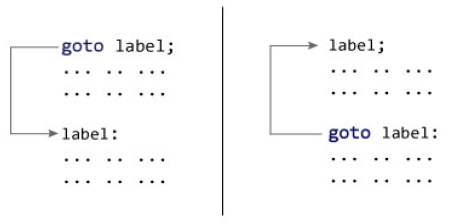C++ goto statement
In this article, we are going to learn about goto statement.
In C++ programming, goto statement is used for altering the normal sequence of program
execution by transferring control to some different part of the program.
The syntax of the goto statement in C++ is:
goto label;
... .. ...
... .. ...
label:
statement;
... .. ...
In above syntax, label is an identifier. When goto label; is encountered,
the control of program went to label: and starts executing the code.
Example :
// Program to calculate the sum and average of positive numbers
// If user enters negative number by mistake, it ignores the number and
// calculates the average of all numbers entered before it.
# include <iostream>
using namespace std;
int main() {
float number, avg, sum = 0.0;
int a, n;
cout << "Maximum number of inputs: ";
cin >> n;
for(a = 1; a <= n; ++a) {
cout << "Enter n" << a << ": ";
cin >> number;
cout << endl;
if(number < 0.0) {
// Control of the program move to jump:
goto jump;
}
sum += number;
}
jump:
avg = sum / (a - 1);
cout << "\navg = " << avg;
return 0;
}
Output :
Maximum number of inputs: 10
Enter n1: -5.6
Enter n2: 2.4
Enter n3: 3.6
avg= 3.0
We can write a C++ program without using goto Statement.
Note : Using goto Statement in our program is a bad programming practice.
Why we should avoid using GOTO STATEMENT in our program?
-
The goto statement helps us to jump to any part of program easily without reading whole code but, makes the working of the program complex .
-
Nowadays programming, GOTO statement is considered a bad programming practice.
-
The GOTO statement can be easily replaced in most of C++ programs with the use of break and continue statements.

